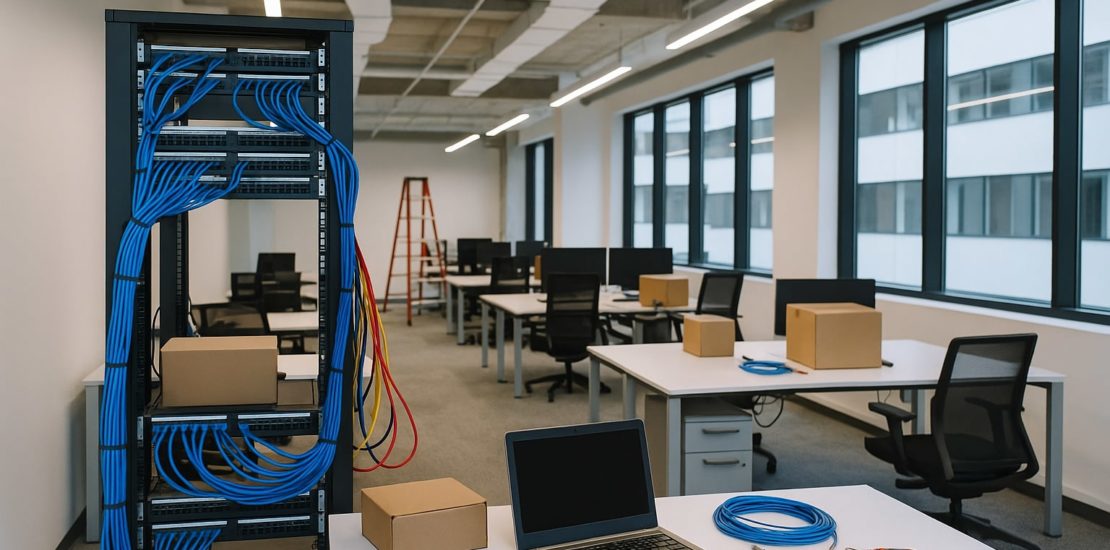How to Plan a Seamless IT Infrastructure Setup for Your New Office
- May 1, 2025
- Posted by: Gradeon
- Categories: Digital Services, IT Infrastructure

Setting up a new office can be exciting. But without the right IT planning, things can go wrong quickly. From poor Wi-Fi signals to missing cables, small issues can delay your operations and cost money. That’s why a well-thought-out IT infrastructure setup is critical.
In this blog, you’ll learn simple and effective steps to plan and execute a smooth IT setup for your new office.
1. Start with a Clear Assessment
Before installing any hardware or running cables, take time to understand your business needs. Ask yourself:
- How many employees will work from the new office?
- What devices will they use — laptops, desktops, VoIP phones?
- Will your team grow in the next 6–12 months?
- What are your software and bandwidth requirements?
Having clear answers will help you avoid last-minute surprises and allow you to design a setup that supports your day-to-day work.
2. Design a Future-Proof Network
Your network is the backbone of your IT infrastructure. Design it with both current needs and future growth in mind.
- Choose a layout that supports both wired and wireless connections.
- Place routers and Wi-Fi access points to avoid dead zones.
- Use commercial-grade switches and structured cabling for stability.
- Don’t forget backup internet if your work depends on uptime.
A well-planned network ensures that your team can work without disruption.
3. Install Reliable Cabling and Power
Cabling is often overlooked, but it plays a vital role in performance and reliability.
- Use quality Ethernet cables (Cat6 or above).
- Plan cable routes before furniture is installed.
- Label cables for easy maintenance.
- Ensure you have enough power outlets and surge protectors.
Also, include Uninterruptible Power Supplies (UPS) to keep your systems safe from outages.
4. Set Up Audio-Visual and Communication Systems
If your team relies on regular meetings or presentations, having the right AV setup matters.
- Equip conference rooms with smart screens and quality microphones.
- Install intercoms or paging systems for internal communication.
- Use VoIP for affordable and flexible phone services.
- Consider wireless presentation tools for better collaboration.
These systems help teams communicate clearly and boost productivity.
5. Implement Strong Security Measures
Security should be part of your IT plan from day one.
- Install a business-grade firewall to block external threats.
- Use strong Wi-Fi passwords and change default login credentials.
- Set up access control — not everyone should have full access to everything.
- Install surveillance cameras in server and equipment rooms.
These simple steps protect your data and reduce the risk of downtime or breaches.
6. Work with IT Experts
Handling a full IT setup on your own can be overwhelming. This is where partnering with professional IT infrastructure services providers makes a big difference.
- They can help you choose the right equipment tailored to your business needs.
- They will professionally install your systems and thoroughly test everything.
- They’ll also ensure all your systems comply with industry best practices and safety standards.
Working with experts in IT infrastructure services saves time, reduces costs, and helps you avoid costly mistakes.
7. Test Everything Before Moving In
Once everything is installed, don’t wait for the first workday to find problems. Test your systems in advance.
- Check internet speed and coverage.
- Confirm phones, printers, and AV tools are working.
- Test backup systems like UPS and generators.
- Get feedback from a few staff members using the systems.
This final step ensures a smooth transition and fewer issues after the move.
Final Thoughts
Planning an IT infrastructure for a new office may seem complex, but it doesn’t have to be. With proper planning, quality equipment, and expert help, you can set up a workspace that’s fast, secure, and reliable from day one.
Whether it’s cabling, AV systems, or secure Wi-Fi, every part of your setup plays a role in business success. So, invest time upfront — it will save you stress later.
